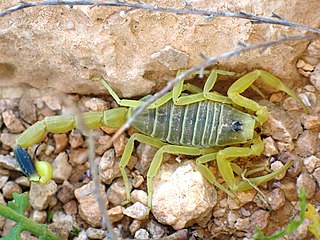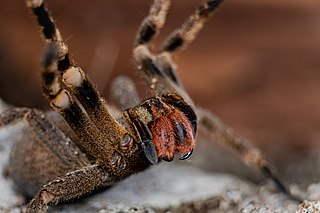Related Research Articles

Venom or zootoxin is a type of toxin produced by an animal that is actively delivered through a wound by means of a bite, sting, or similar action. The toxin is delivered through a specially evolved venom apparatus, such as fangs or a stinger, in a process called envenomation. Venom is often distinguished from poison, which is a toxin that is passively delivered by being ingested, inhaled, or absorbed through the skin, and toxungen, which is actively transferred to the external surface of another animal via a physical delivery mechanism.

Atracidae is a family of mygalomorph spiders, commonly known as Australian funnel-web spiders or atracids. It has been included as a subfamily of the Hexathelidae, but is now recognised as a separate family. All members of the family are native to Australia. Atracidae consists of three genera: Atrax, Hadronyche, and Illawarra, comprising 35 species. Some members of the family produce venom that is dangerous to humans, and bites by spiders of six of the species have caused severe injuries to victims. The bites of the Sydney funnel-web spider and northern tree-dwelling funnel-web spider are potentially deadly, but no fatalities have occurred since the introduction of modern first-aid techniques and antivenom.

Antivenom, also known as antivenin, venom antiserum, and antivenom immunoglobulin, is a specific treatment for envenomation. It is composed of antibodies and used to treat certain venomous bites and stings. Antivenoms are recommended only if there is significant toxicity or a high risk of toxicity. The specific antivenom needed depends on the species involved. It is given by injection.

The deathstalker is a species of scorpion, a member of the family Buthidae. It is also known as the Palestine yellow scorpion, Omdurman scorpion, and Naqab desert scorpion, as well as by many other colloquial names, which generally originate from the commercial captive trade of the animal. To eliminate confusion, especially important with potentially dangerous species, the scientific name is normally used to refer to them. The name Leiurus quinquestriatus roughly translates into English as "five-striped smooth-tail". In 2014, the subspecies L. q. hebraeus was separated from it and elevated to its own species Leiurus hebraeus. Other species of the genus Leiurus are also often referred to as "deathstalkers". Leiurus quinquestriatus is yellow, and 30–77 millimetres (1.2–3.0 in) long, with an average of 58 mm (2.3 in).

Phoneutria nigriventer is a species of medically significant spider in the family Ctenidae, found in the Southern Cone of South America. Along with other members of the genus, they are often referred to as Brazilian wandering spiders.

Delta atracotoxin is a low-molecular-weight neurotoxic polypeptide found in the venom of the Sydney funnel-web spider.

Latrodectism is the illness caused by the bite of Latrodectus spiders. Pain, muscle rigidity, vomiting, and sweating are the symptoms of latrodectism.

Venomous fish are species of fish which produce strong mixtures of toxins harmful to humans which they deliberately deliver by means of a bite, sting, or stab, resulting in an envenomation. As a contrast, poisonous fish also produce a strong toxin, but they do not bite, sting, or stab to deliver the toxin, instead being poisonous to eat because the human digestive system does not destroy the toxin they contain in their bodies. Venomous fish do not necessarily cause poisoning if they are eaten, as the digestive system often destroys the venom.
Taipoxin is a potent myo- and neurotoxin that was isolated from the venom of the coastal taipan Oxyuranus scutellatus or also known as the common taipan. Taipoxin like many other pre-synaptic neurotoxins are phospholipase A2 (PLA2) toxins, which inhibit/complete block the release of the motor transmitter acetylcholine and lead to death by paralysis of the respiratory muscles (asphyxia). It is the most lethal neurotoxin isolated from any snake venom to date.
The Membrane Attack Complex/Perforin (MACPF) superfamily, sometimes referred to as the MACPF/CDC superfamily, is named after a domain that is common to the membrane attack complex (MAC) proteins of the complement system and perforin (PF). Members of this protein family are pore-forming toxins (PFTs). In eukaryotes, MACPF proteins play a role in immunity and development.
Venom-induced consumption coagulopathy (VICC) is a medical condition caused by the effects of some snake and caterpillar venoms on the blood. Important coagulation factors are activated by the specific serine proteases in the venom and as they become exhausted, coagulopathy develops. Symptoms are consistent with uncontrolled bleeding. Diagnosis is made using blood tests that assess clotting ability along with recent history of envenomation. Treatment generally involves pressure dressing, confirmatory blood testing, and antivenom administration.

Synanceia is a genus of ray-finned fish belonging to the subfamily Synanceiinae, the stonefish, which is classified within the family Scorpaenidae, the scorpionfish and relatives. Stonefish are the most venomous fish known; stings can be fatal to humans. They are found in the coastal regions of the Indo-Pacific.

A scorpion sting is an injury caused by the stinger of a scorpion resulting in the medical condition known as scorpionism, which may vary in severity. The anatomical part of the scorpion that delivers the sting is called a "telson". In typical cases, scorpion stings usually result in pain, paresthesia, and variable swelling. In serious cases, scorpion stings may involve the envenomation of humans by toxic scorpions, which may result in extreme pain, serious illness, or even death depending on the toxicity of the venom.
TsIV is a toxin from the venom of the Brazilian scorpion Tityus serrulatus which slows the inactivation of sodium channels.
The pathophysiology of a spider bite is due to the effect of its venom. A spider envenomation occurs whenever a spider injects venom into the skin. Not all spider bites inject venom – a dry bite, and the amount of venom injected can vary based on the type of spider and the circumstances of the encounter. The mechanical injury from a spider bite is not a serious concern for humans. Some spider bites do leave a large enough wound that infection may be a concern. However, it is generally the toxicity of spider venom that poses the most risk to human beings; several spiders are known to have venom that can cause injury to humans in the amounts that a spider will typically inject when biting.
Spinoxin is a 34-residue peptide neurotoxin isolated from the venom of the Malaysian black scorpion Heterometrus spinifer. It is part of the α-KTx6 subfamily and exerts its effects by inhibiting voltage-gated potassium channels, specifically Kv1.2 and Kv1.3.
Mipartoxin-I is a neurotoxin produced by Micrurus mipartitus, a venomous coral snake distributed in Central and South America. This toxin causes a neuromuscular blockade by blocking the nicotinic acetylcholine receptor. It is the most abundant component in the venom.
Perivitellin-2 (PV2) is a pore-forming toxin present in the egg perivitelline fluid of the apple snails Pomacea maculata (PmPV2) and Pomacea canaliculata (PcPV2). This protein, called perivitellin, is massively accumulated in the eggs. As a toxin PV2 protects eggs from predators, but it also nourishes the developing snail embryos.
Ts8 is a neurotoxin present in the venom of the Brazilian yellow scorpion, Tityus serrulatus. Ts8 is a selective inhibitor of the voltage-gated potassium channel Kv4.2
References
- 1 2 Poh CH, Yuen R, Khoo HE, Chung M, Gwee M, Gopalakrishnakone P (1991). "Purification and partial characterization of stonustoxin (lethal factor) from Synanceja horrida venom". Comparative Biochemistry and Physiology. B, Comparative Biochemistry. 99 (4): 793–8. doi:10.1016/0305-0491(91)90143-2. PMID 1790672.
- 1 2 Johnson DA, Sreebny LM (February 1973). "Effect of isoproterenol on synthesis and secretion in the rat parotid gland". Laboratory Investigation; A Journal of Technical Methods and Pathology. 28 (2): 263–9. PMID 4687532.
- ↑ Darlene FO, Phee-Kheng C (30 April 2013). "Hot water immersion as a treatment for stonefish sting: A case report". Malaysian Family Physician. 8 (1): 28–32. PMC 4170453 . PMID 25606265.